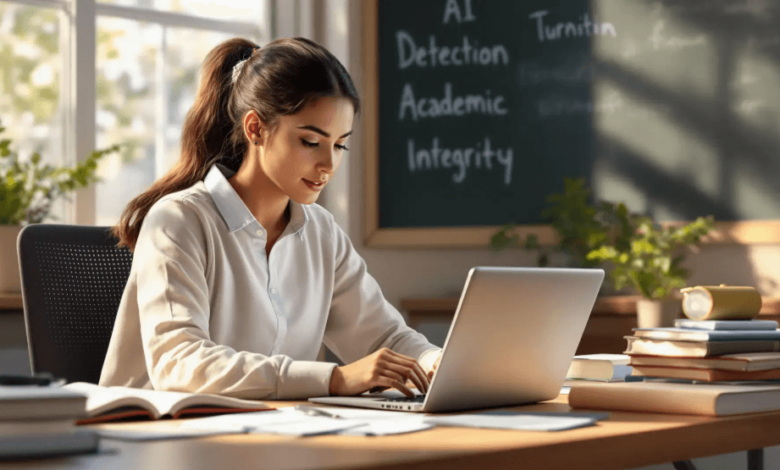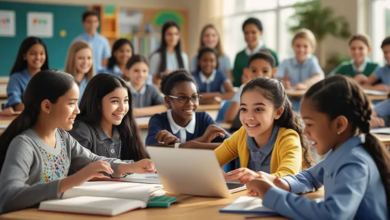Can Schools Detect ChatGPT? What You Need to Know About AI Detection in Education

With the rise of AI, students now have access to sophisticated tools that can help them create impressive work. With this new technology comes a crucial question: Can schools tell if AI created a student’s work? Understanding detection methods is essential for both maintaining academic integrity and promoting authentic learning. This article will explore how schools work to detect AI-generated content and what this means for both students and teachers.
What Schools Can Detect ChatGPT
There is an ongoing debate about the authenticity and quality of student work, especially with the advent of artificial intelligence. This includes tools such as ChatGPT. To maintain academic standards, universities and schools want to know if students use AI to complete their assignments. How effectively can they detect this?
At present, there are several methods that schools can use to detect AI-generated content. Although AI-generated texts are only detectable in a limited way, significant progress is being made to improve detection abilities. Many educational institutions use plagiarism detection software such as Turnitin and other AI content analysis tools to scan student work for AI involvement. These tools scan text for anomalies and patterns characteristic of AI writing. This indicates that the work may not be 100% human-generated.
In situations where academic integrity is at risk, detection becomes a necessity. Take law schools, for example, where students may use AI tools to write essays or legal briefs. The American Bar Association highlights the difficulty of enforcing AI bans, but it’s clear that measures are needed to determine the authenticity and quality of student work. Universities are also wary of false positives. Some universities have stopped using certain AI-detection tools out of fear of falsely accusing students of cheating. This highlights the delicate balance that needs to be maintained.
In fact, the ability to detect AI-generated content is an area that has been growing in interest. Schools are aware that AI can negatively impact educational fairness. They need to use strict methods to encourage learning and original thinking. As technology advances, so will the tools that ensure student work is authentic and reflects their abilities.
See also: The Best Platforms for Authentic Instagram Growth
Why Schools Detect ChatGPT
Schools face new challenges as artificial intelligence becomes more integrated into educational institutions. A significant concern is detecting AI-generated content such as essays or assignments generated by tools like ChatGPT. Why are schools taking such measures to detect ChatGPT?
Academic Integrity and Plagiarism Concerns
Academic integrity is the cornerstone of education. Schools strive to create an environment that values original and honest work. Students who use AI for their assignments raise questions about their authenticity. Turnitin and other plagiarism detection tools widely used in educational institutions have been adapted to detect AI-generated content. However, these tools are not foolproof and can sometimes be inaccurate, as demonstrated by recent tests.
Educational Fairness and Equal Opportunities
Maintaining fairness in education is another critical reason for detecting AI-generated content. If some students use ChatGPT to complete their work while others do not, it creates an uneven playing field. Unequal access to AI tools can disadvantage those who strive to produce their work independently and honestly. Educational equity is a priority, and schools are keen to ensure that all students have a fair chance to succeed based on their abilities, not on the capabilities of AI.
Encouraging Original Thought and Learning
Education’s primary objective is to foster critical thinking and intellectual growth. Students who rely on AI for their homework miss out on valuable learning opportunities that can only be gained by tackling difficult problems and constructing coherent arguments. Educational institutions want students to be engaged in their work and to think about it deeply instead of taking shortcuts that hinder their intellectual development.
AI detection tools are designed to distinguish between AI-generated and human-generated text. However, these tools still face challenges in accurately identifying AI content. Institutions like Vanderbilt and other major universities have reconsidered the use of these detection tools, finding that they sometimes cause more problems than they solve.
How to Detect ChatGPT in Schools
The detection of AI-generated content, such as work produced by ChatGPT, has become an urgent issue for educational institutions. Schools have developed and are using various methods to differentiate between AI-created and human-created content. Let’s examine these methods in more detail.
AI Detection Tools
Artificial intelligence detection software is increasingly used to identify AI-generated content. These tools use sophisticated algorithms to analyze texts for patterns and structures indicative of AI-generated writing. AI detection tools have become essential in today’s educational environment, as traditional plagiarism checks cannot identify generative AI content.
AI Plagiarism Checkers: These tools do not only look for duplicate text but also analyze the way text is composed. The tools compare student work with a database of AI-generated outputs and highlight any similarities. You can read this article to learn more about the limitations and effectiveness of these tools.
Natural Language Processing (NLP)
NLP is key to detecting AI-generated content. The process involves complex algorithms that interpret and create human language. NLP can be used to detect content that appears “synthetic.” It examines the style, coherence, and language of the written text.
Language Style Analysis: NLP includes analyzing the writing style. Human writing tends to be more personal and varied than AI-generated text. Detection tools use these differences to identify potential AI content.
Sentiment Analysis: Some tools analyze tone and sentiment, noting that AI-generated text can have a more neutral and flat feel than human writing, which typically features a range of emotional undertones.
Expert Insights
Experts have varying opinions on the effectiveness of AI detection. As discussed in this article, Australian universities have experienced both success and failure in this area. AI enthusiast Dr. Chris McKay notes, “As AI improves, so do the tools to identify it.” This continual improvement is crucial as students and teachers grapple with the sophisticated nature of AI-generated texts.
The Human Element
Teachers play a crucial role in detecting AI-generated content. Their familiarity with students’ writing styles allows them to notice discrepancies in quality or other unusual changes.
Educator Awareness: Teachers can identify differences in writing style, vocabulary, and comprehension that might suggest AI involvement. Check out the method teachers use at Irvington High School for more insight.
Custom Assessments: AI tools cannot replicate the critical thinking and in-depth knowledge required by many teachers. By creating questions that require personalized responses, educators can reduce the likelihood of students relying solely on AI.
Emerging Challenges
Despite advances in detection, identifying AI-generated content remains a challenge. The main problem is that AI systems such as OpenAI’s GPT-3 and GPT-4 continue improving, making distinguishing their outputs from human writing harder.
False Positives and Negatives: AI detection tools do not always work. Sometimes, they can incorrectly label genuine student work, leading to unfair accusations. On the other hand, highly sophisticated AI-generated content may go undetected.
Student Privacy: Increased surveillance to detect AI use can also encroach on student privacy. To understand the broader implications, read more about how increased surveillance impacts the educational environment.
Conclusion
As AI tools like ChatGPT become more integrated into educational environments, schools face both challenges and opportunities. The rise of AI-generated content has raised important questions about academic integrity, fairness, and the preservation of authentic learning experiences. While detection methods are still evolving, a multi-faceted approach involving AI detection tools, natural language processing, and the keen eye of educators is essential to preserving the integrity of student work.
Ultimately, the goal should not be just to catch AI-generated content but to ensure that students are encouraged to think critically, engage deeply with their learning, and develop the skills that will benefit them beyond the classroom. As AI continues to advance, so too must how schools support and nurture independent, authentic learning.




